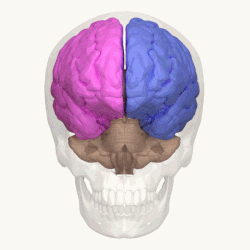
Back نصف كرة مخية Arabic Hemisferiu cerebral AST Beyin yarımkürələri AZ Moždana hemisfera BS Hemisferi cerebral Catalan Mozková hemisféra Czech Hemisffer cerebrol CY Εγκεφαλικά ημισφαίρια Greek Cerba duonsfero EO Hemisferio cerebral Spanish
| Cerebral hemisphere | |
|---|---|
 Human brain seen from front. | |
 Right cerebral hemisphere Left cerebral hemisphere | |
| Details | |
| Identifiers | |
| Latin | hemisphaerium cerebri |
| NeuroNames | 241 |
| NeuroLex ID | birnlex_1796 |
| TA98 | A14.1.09.002 |
| TA2 | 5418 |
| FMA | 61817 |
| Anatomical terms of neuroanatomy | |
The vertebrate cerebrum (brain) is formed by two cerebral hemispheres that are separated by a groove, the longitudinal fissure. The brain can thus be described as being divided into left and right cerebral hemispheres. Each of these hemispheres has an outer layer of grey matter, the cerebral cortex, that is supported by an inner layer of white matter. In eutherian (placental) mammals, the hemispheres are linked by the corpus callosum, a very large bundle of nerve fibers. Smaller commissures, including the anterior commissure, the posterior commissure and the fornix, also join the hemispheres and these are also present in other vertebrates. These commissures transfer information between the two hemispheres to coordinate localized functions.
There are three known poles of the cerebral hemispheres: the occipital pole, the frontal pole, and the temporal pole.
The central sulcus is a prominent fissure which separates the parietal lobe from the frontal lobe and the primary motor cortex from the primary somatosensory cortex.
Macroscopically the hemispheres are roughly mirror images of each other, with only subtle differences, such as the Yakovlevian torque seen in the human brain, which is a slight warping of the right side, bringing it just forward of the left side. On a microscopic level, the cytoarchitecture of the cerebral cortex, shows the functions of cells, quantities of neurotransmitter levels and receptor subtypes to be markedly asymmetrical between the hemispheres.[1][2] However, while some of these hemispheric distribution differences are consistent across human beings, or even across some species, many observable distribution differences vary from individual to individual within a given species.
- ^ Anderson B, Rutledge V (December 1996). "Age and hemisphere effects on dendritic structure". Brain. 119 (6): 1983–1990. doi:10.1093/brain/119.6.1983. PMID 9010002.
- ^ Hutsler J, Galuske RA (August 2003). "Hemispheric asymmetries in cerebral cortical networks". Trends in Neurosciences. 26 (8): 429–435. CiteSeerX 10.1.1.133.2360. doi:10.1016/S0166-2236(03)00198-X. PMID 12900174. S2CID 15968665.